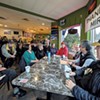Published March 19, 2003 at 3:09 p.m.
In an unprecedented move 10 years ago, the National Trust for Historic Preservation placed the entire state of Vermont on its annual endangered list. The dubious distinction suggested the Green Mountain state is not just a spot on the map, but a unique culture shaped by rural life and its attendant civic traditions. This singular sociology has attracted scores of strip-mall-weary settlers and informs the region's politics and culture.
Anyone who has visited Williston lately knows the state is losing ground to sprawl and big-box commerce. Another, less glaring casualty is the grassroots democracy that has grown up around small towns. Citizens of burgeoning municipalities rarely volunteer for local selectboards. Some view the erosion of traditional landscape and attitudes as a battle against inevitability. Others - like uber-planner Beth Humstone - see it as an opportunity to learn from the rest of America's mistakes.
"There are a lot of shared values in Vermont," observes Humstone, who is executive director of the Vermont Forum on Sprawl. "People really care about communities and the health of our downtowns. They care about the countryside. They care about farming. They care about forestry. They care about clean air. You can talk to people that you might disagree with on how to accomplish those things, but you usually can agree on the goals. You don't see that in a lot of parts of this country."
Humstone's view of Vermont is as clear as it gets, honed from years of integrating seemingly conflicting interests to come up with an action plan. "She can go from the strategic part of advocacy - the political work, who to talk to - all the way over to how to talk to planners about what technically has to change in order for things to work differently," says Elizabeth Humphrey at the Growth Management Leadership Alliance in Washington, D.C.
If Vermont still had a planning office - it was abolished during the Dean administration - Humstone would be the logical person to run it. But then she wouldn't be looking into how Montpelier inadvertently contributes to sprawl with infrastructure expenditures that violate the state's own land-use policies - just one of several initiatives she's overseeing in her current job. If anyone sees the big picture, Humstone does.
"Land-use planning" sounds about as sexy as "solid-waste management," but in environments pressured by development, it's what separates green fields from brownfields, condo complexes from open space. Where - and how - Vermonters live, work, shop and recreate shapes the landscape. Envisioning and mapping out future residential areas, transportation routes, wildlife corridors and commercial districts indicates the desire to direct growth in a particular way. Zoning seals the deal.
To say Humstone has had a hand in maintaining Vermont's mostly pristine profile would be an understatement. After two years in the state planning office, she left to work as a consultant, to help many towns take control of their economic and aesthetic destinies. She's also on the Burl-ington Planning Commission and the steering committee of the "Legacy Project," which was charged with imagining a more populous Queen City. Many of the project's findings will be worked into the city's revised municipal development plan, which Humstone is helping to write.
Her commitment to "smart growth" extends beyond individual burgs. During her consulting days, Humstone helped found a state-supported agency that promotes a two-pronged approach to development by funding projects that address affordable housing and land protection. The Vermont Housing and Conservation Board inspired the creation of a network of housing nonprofits around the state. It's the envy of anti-sprawl advocates around the nation.
Now, at the Vermont Forum on Sprawl, Humstone is charged with no less than "protecting the unique qualities of the Vermont landscape and its communities while encouraging economic development in town centers." Her job description breaks down into five basic areas: public policy, education, research, technical assistance and collaboration. Hum-stone has recruited 10 organizations, including one that represents business interests, to form the Vermont Smart Growth Collaborative. It's already getting national attention.
"She's always been ahead of the curve. The rest of the state is catching up," says Julie Campoli, a designer who has worked with Humstone on numerous projects. The two recently co-wrote a book with pilot Alex MacLean that uses aerial photography to document Vermont's land-use trends. Real stories - culled from development challenges in St. Albans, Swanton, Peru and myriad other Vermont towns - accompany the visuals. And along the way you learn a thing or two about easements, infill development and fragmentation.
A number of images from Above and Beyond adorn the walls of Humstone's cramped Main Street office, which she shares with three staffers, her dog Bella and John Ewing, the Forum's founder and board chair. No sprawl here. Juxtaposing an old Waterbury neighborhood with a subdivision in Essex, she points out how driveways and garages dominate in the new development. Her enthusiasm doesn't compromise her cool. Humstone is as articulate as she is analytical. You can easily imagine her poring over old military maps of Italian towns, which she did on a prestigious Rome Prize fellowship in 1985, or hammering out zoning regulations with the citizens of Essex.
"So much of what we're concerned about and involved in is connections," says Humstone. "Cutting off connections, by locating housing way out in one place, shops over here, and the schools over there, requires using an automobile and makes it hard to come together as a community. We are destroying a connection to the past when we destroy a really significant landscape." Taft Corners may be lost forever. But Humstone holds out hope that the rest of Vermont will go the way of Charlotte, which had the foresight back in the 1960s to protect the scenic corridor along Route 7 from commercial development. Now those views of Lake Champlain have been protected in perpetuity.
Humstone is right when she suggests, "A lot of people don't know what a city planner does." But the 54-year-old Burlington resident got a very early introduction to a job that requires not just vision but politicking, diplomacy, public speaking and fluency in legalese. Her father was a consultant and planner for New York City who helped rewrite its zoning laws in 1961. Volunteer projects in environmental protection and historic preservation kept him busy after work.
"Growing up, I remember driving by old, vacant, industrial areas - College Point, Queens and other places - and he'd do these things he called 'windshield surveys,'" Humstone suggests. "He'd say, 'We're trying to figure out what we can do with this land. It's vacant, you know, and there's a road nearby. There's water and sewer. What are we going to do with it?' I'd take notes and he'd tell me what to write."
She also recalls family vacations that revolved around visiting Frank Lloyd Wright buildings and her father's analysis of traffic jams on the way back from Jones Beach on Long Island. "I grew up with books like The Little House, by Virginia Lee Burton, which shows the whole story of suburbanization and how it happens," Humstone says. The book details how a little house in the country gets engulfed by a big bustling city. Imagine the precursor to the video game "Sim City," but with better values.
Humstone's dad clearly influenced her thinking on growth issues. Her sisters were likewise impressed: One is a landscape architect; the other works in historic preservation. But as predestined as her career choice seemed, Humstone was determined not to be a planner. When she landed an internship with the New York City government after four years at Wheaton College, she asked to be placed anywhere but on the planning commission.
Guess where she wound up? "My job was researching the situation in Soho with respect to the artists," says Humstone. In an effort to forestall gentrification, the city was trying to preserve loft spaces for blue-collar workers who still had jobs in the neighborhood. "They wanted us to document the extent to which artists were living in those spaces. It was a detective job. I loved it."
Based on that positive planning experience, she yielded to the family legacy and applied to Harvard's Graduate School of Design - her father's alma mater. But it was not with an urban planning goal in mind. "I wanted to work in a rural area that had not yet experienced this tremendous suburban sprawl and decline, to see if there was a better way for these areas to grow and evolve," Humstone explains.
Post-graduation and newly married, she considered three destinations. Vermont won out over Hawaii and Oregon. "The state had already expressed a desire to do things differently when it passed Act 250 in 1970," Humstone reasoned. She arrived in 1973, just in time to feel the backlash. After a short stint at Garden Way and a gig with a landscape architect, she found herself at the center of the action, in the state planning office under then-Gover-nor Salmon.
Originally, there was a state-wide land-use plan attached to Act 250. Humstone found Vermonters' negative reaction to it "very instructive. It would make sense, you would think, to put a map on the wall illustrating the state's vision for the future. But when you start drawing lines, people realize, 'Oh, I'm in the 25-acre zone,' or 'Oh, I'm in the no-build zone.' It can get very emotional." The experience taught Humstone a lot about how diverse groups reach consensus on growth issues - skills she brought to individual towns as a planning consultant.
"In my mind, what makes a good planner is someone who understands the relationship between the regulations and the built environment that will result from them - the outcome. Beth is very good at that," says Campoli. "That comes from years of looking at growth, and how things change, being very observant. She's been interested in this all her life, and she's traveled a great deal."
Humstone spent her honeymoon traveling overland from London to India via Afghanistan. But she learned more about urban design and sprawl during the year she spent in Italy. Humstone beat out aspiring painters, sculptors and architects for a Rome Prize to study the evolution of small Italian towns, some of which were more than 2000 years old.
She discovered strip development is a very old concept. "There has always been a concentration of commerce at the gates of these towns." Density also dates back. "If you had a piece of land in town, and didn't build on it, you would lose it," she explains. "They didn't do it for aesthetics, they did it for the health of the community."
Happily, what made practical sense in Italy turned out to be beautiful - and still appeals to hordes of tourists. The same could be said of traditional settlement patterns in Vermont. Protecting the landscape is not just a matter of preserving Green Mountain visuals, but also an economic imperative. Notably, Humstone doesn't believe in imitating historic buildings or in mandating taste. "If you get too specific you lose the opportunity for some bold new design," she suggests. "I guess I'm more concerned about form and placement of buildings on lots."
Take downtown Bristol, for example, where the buildings are close to the street. "When you're close up, you're noticing windows and doorways and it's not necessary to be so particular about design," Humstone suggests. "But when you have a mini-mart set back 100 feet with a big parking lot, there's much more emphasis on the building."
Those are the sort of practical planning tips she brought as a consultant to towns like West-ford, Peru, Georgia and Charlotte, where she lived until 1991, three years after her divorce. Later she teamed up with fellow planner Jeff Squires - who now works on transportation issues for Senator James Jeffords - and took on Essex, Barre and Williston. Award-winning architect Turner Brooks was part of the team that tackled Taft Corners.
So how did Williston end up with all that asphalt? Humstone and Squires shepherded citizens through the usual process: polling citizen attitudes, compiling the research, facilitating meetings and hammering out a comprehensive plan with design charettes and other visuals.
"We came up with a plan for that area that envisioned Taft Corners as what we were then calling an 'urban village,'" Humstone recalls. "It would have a network of streets like you would see in any other town center. There would be public uses, such as a post office and a school. There would be offices with retail on the ground floor, apartments upstairs, that kind of thing."
Ultimately, though, the zoning didn't reflect the plan the citizens of Williston approved. During the hearing process, "there was a lot of pressure from the development community. They said it was pie-in-the-sky planning," Humstone explains. "They basically struck a deal with the Selectboard at the time that reserved a certain amount of land for retail development in the Taft Corners area and also tremendously weakened the zoning so it would never carry out the plan adopted by the town. It was the citizens of Williston who lost out in the end."
The New Jersification of Williston underscored the need for an organization - in the absence of a state planning office - that could oversee statewide land-use issues, especially high-impact developments like Taft Corners. John Ewing was chair of the state environmental board when he decided to launch the Vermont Forum on Sprawl. "It was obvious Vermont was growing in a way that was sucking the life out of the village centers and downtowns," he recalls. Prior to that, Ewing was chair of the district environmental commission in Chittenden County.
The goal of the forum was to bring environmental and business groups together to revitalize downtowns while preserving surrounding farmland. Ewing hired Humstone as assistant director because of her extensive and varied experience in land-use planning, and because she was not adverse to a mission statement that included the term "economic development." "It's how and where the growth occurs, reinforcing the values and strengths of Vermont rather than eroding them," Ewing explains.
For her part, Humstone had been thinking about quitting her consulting business and starting a nonprofit to address sprawl. Working with towns was getting repetitive, and she really wanted to be part of a "mission-driven" organization. "I have strong values about planning and what planning is all about. And it's often difficult to work in communities where you are trying to help them through a process, help them realize their vision, but you see what they are doing is, in the long run, going to be a problem for them and for the area."
In 2000, Humstone took over as the Forum's executive director - a position that draws on all her experience and skills, from designing opinion polls and evaluating housing projects to diplomacy and networking.
Recently she's been getting national publicity for organizing the Vermont Smart Growth Collaborative, which brings together a handful of Vermont groups with varied expertise regarding sprawl. "With coordinated foundation financing and a mutually agreed-on work plan, the 10 Vermont groups seem positioned to make a major impact on their state," wrote Neal Peirce, a journalist who covers growth issues, in his nationally syndicated column. He also praised the Vermont collaborative for supporting economic incentives for developing downtowns, endorsing well-placed housing developments and "readying a report card to show how well - or poorly - a host of state spending and regulation policies match smart growth priorities."
Humstone's reputation has grown to the point where she is turning down invitations to speak around the country. After all, too many forays might blur her focus on Vermont. A few other landscapes have drawn her, though - in particular, Arizona's Sonora Desert. But for now Humstone is staying put. "She has a real deep love of the state," says Campoli. "Her interest is in having it remain beautiful for at least the next couple hundred years."
More By This Author
Speaking of Local Issues, planning And Zoning
-

Keeping Plan BTV-South End Arty
Sep 25, 2014 -

At the Junction of State and Federal Law, I-91 Checkpoint Becomes Site of Legal Collision
Feb 5, 2014 -

Maple Makeover? Vermonters Discover a New Sugaring Technique
Feb 5, 2014 -

Disharmony on Prospect Street: A Dispute Between Neighbors Strikes a Sour Note
Feb 5, 2014 -

Treatment or Trial? Growing 'Rapid-Intervention' Program Gives Addicted Offenders a Choice
Jan 29, 2014 - More »
Comments
Comments are closed.
From 2014-2020, Seven Days allowed readers to comment on all stories posted on our website. While we've appreciated the suggestions and insights, right now Seven Days is prioritizing our core mission — producing high-quality, responsible local journalism — over moderating online debates between readers.
To criticize, correct or praise our reporting, please send us a letter to the editor or send us a tip. We’ll check it out and report the results.
Online comments may return when we have better tech tools for managing them. Thanks for reading.














































